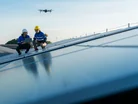McKinsey: Tech can Help Construction Address Staffing Issue

McKinsey research shows an ageing workforce combined with sky-high demand for workers is one of the major problems facing the US construction industry.
The US skilled labour market is struggling to balance worker supply and demand. Construction, along with manufacturing, are two of the hardest hit sectors, with healthcare and finance also experiencing substantial workforce departures and insufficient trainees or graduates to replace them.
According to the Organisation for Economic Co-operation and Development (OECD), the ratio of retirement-age people to working-age people in the US skilled labour market will have increased by between 1984 and 2027.
McKinsey says construction in particular is experiencing high demand for talent as infrastructure projects and real estate redevelopment take off.
It says that between 2024 and 2030, the global renewables industry will require an extra 1.1 million blue-collar workers for wind and solar plant development and construction and another 1.7 million workers to operate and maintain them.
McKinsey points out that “company-level strategies are not enough to address systemic pipeline issues''. These issues, it says, “demand new solutions created in partnership by the private sector, government, and educational institutions”.
McKinsey: tech can ease construction staffing issues
However, the report goes on to identify three ways technology can be used to help tackle workforce challenges on an organisational level.
- Leveraging generative AI to help onboard and train new employees
Using genAI can help new employees track their tasks and answer questions in real time, says McKinsey. This, it adds, helps companies retain scarce skilled workers. - Automating tasks to free employee time to focus on greater value-add work
McKinsey gives as an example heavy equipment manufacturers, who use collaborative robots alongside human workers to automate repetitive tasks and free up employees for more complex and analytical work. This, it says, can enhance productivity by as much as 40% and improve resource utilisation by 50%. - Adopting technology to enable remote work and flexibility
Digital twins and remote-control technologies can enable technicians to operate and debug factory equipment from anywhere in the world, says McKinsey. The resulting increased flexibility can reduce vacancies by 25% and has the potential to double productivity.
Productivity, it stresses, is “a critical consideration”. The report says productivity growth in advanced economies has slowed by roughly 1% since the global financial crisis of 2008.
- AWS' Mission to Reduce the Environmental Impact of BuildingsTechnology & AI
- HCM: Harnessing AI to Reduce Machinery DowntimeTechnology & AI
- Why LanzaJet's SAF Plant is a Game-Changer for AviationSustainability & Green Building
- Generation: How Green Trends are Impacting ConstructionSustainability & Green Building



